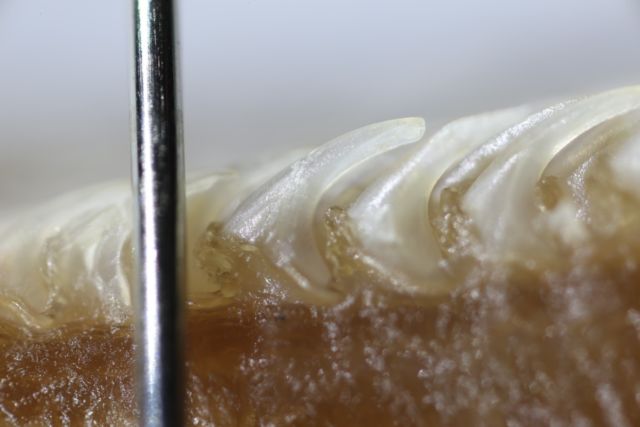There's rarely time to write about every cool science story that comes our way. So this year, we're running a special Twelve Days of Christmas series of posts, highlighting one story that fell through the cracks each day, from December 25 through January 5. Today: new insights into how cats clean their fur.
That sandpaper-like texture of your cat's tiny pink tongue is what makes it ideal for grooming fur. The secret: hundreds of hollow, rigid spines lining the surface of the tongue, according to a recent paper published in the Proceedings of the National Academy of Sciences.
This is just the latest bit of colorful research from David Hu, who runs a biolocomotion laboratory at the Georgia Institute of Technology studying how various creatures move. He is perhaps best known for his work with fire ants, but his lab also studies water striders, snakes, various climbing insects, mosquitos, and, um, animal bodily functions like urine. (One of his students, Patricia Yang, recently made headlines with her insights into why wombats produce cubed poo.)
It was another of Hu's graduate students, Alexis Noel, who came up with the idea for the cat tongue experiments. She was watching her cat try to "groom" a fluffy microfiber blanket one night and noticed its tongue kept getting snagged in the fibers. She found very little prior research on the biomechanics of cat grooming, and concluded the topic was ripe for experimentation.
A cat's fur consists of a top coat with very thick hairs, and an undercoat with lots of thin downy hairs that help keep the animal warm. Grooming is a necessary activity to untangle the fur and remove fleas, debris, even excess heat so the cat can cool off, since cats only have sweat glands on the pads of their paws (or "toe beans," if you prefer). Without grooming, the fur quickly becomes hopelessly matted and sometimes infections occur. Domestic cats sleep up to 14 hours a day; they spend a big chunk of their waking hours on grooming. A cat's tongue is ideally suited for this purpose because it's carpeted with lots of sharp, hollow spines called "papillae," containing the same keratin found in hair and claws.
Gathering lick pics
Researchers first captured footage of a domestic cat grooming using a high-speed video camera. Then, they recorded a separate sequence of a cat grooming a fake fur surface that was attached to a force plate in order to measure how much force was being applied. The Georgia Tech team identified four distinct phases to the licking motion: extending the tongue, expanding and stiffening the tongue tissue, sweeping the tongue through the fur, and retracting the tongue via a U-shaped curl.
During the second phase of licking—the expansion phase—they noted that the spines rotated until they were perpendicular to the tongue, increasing their contact area with the fur. They hypothesize that hair is removed by the tongue during retraction by the thick wavy patterns (rugullae) on the roof of the cat's mouth.
For the next phase of the research, the team collected severed cat tongues from six different species: a domestic cat, a bobcat, a cougar, a snow leopard, a tiger, and a lion. That proved a bit of a challenge, since "there aren't a lot of tongues just sitting around," Hu told National Geographic. In the end, their persistence in nagging zoos and animal reserves paid off, and they had the specimens they needed to perform CT scans on each tongue.

Since 1982, scientists assumed cat tongues were shaped like a hollow cone. The Georgia Tech team, however, discovered that the papillae actually curve backward towards the throat, enabling them to exploit surface tension to wick up water via capillary action—the same way plants absorb water from soil. That saliva is then deposited throughout the fur during grooming. Over the course of a day, a domestic cat can transfer up to a fifth of a cup of water to its fur.
Ultimately, how efficiently a cat grooms depends upon how deeply the papillae can penetrate the fur to reach the skin underneath the cat's topcoat and undercoat. The cat's tongue presses down on the fur as it licks, compressing the hairs to push out the air, making it easier to reach the skin. Hu et al. found that the caracal, cheetah, and leopard are the most "groomable" because of their short, sparse fur. Only two breeds of domestic cat proved to be "ungroomable," both Persians. The papillae just can't get through all that long hair to reach the skin, which is why the Veterinary Centers of America recommend daily brushing for owners of Persian cats.
Persians aside, a cat's tongue is so good at grooming fur that Hu and his team developed a "tongue-inspired grooming" (TIGR) brush, mimicking the structure with 3D-printed artificial papillae embedded in a flexible pad of silicone. It's easier to clean, and tugs less at hair during brushing. According to Hu, might even prove useful for getting topical medications directly onto cats' skin, because it can penetrate the fur so well.
Please, please, please, just let the commercial version not look like the giant silicone LICKI tongue some excessively devoted cat owners use to groom their cats for them. The cats have got this, people. Except for the Persians.
DOI: PNAS, 2018. 10.1073/pnas.1809544115 (About DOIs).
Listing image by David Hu/Georgia Tech
[contf] [contfnew] 
Ars Technica
[contfnewc] [contfnewc]







